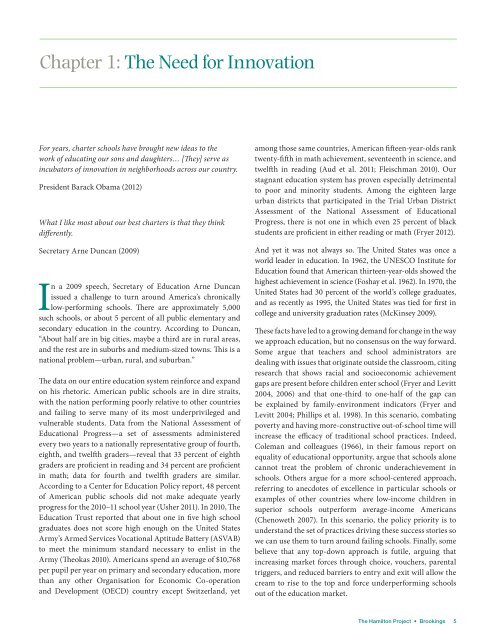The 21st Century Charter Schools Initiative
The 21st Century Charter Schools Initiative
The 21st Century Charter Schools Initiative
Create successful ePaper yourself
Turn your PDF publications into a flip-book with our unique Google optimized e-Paper software.
Chapter 1: <strong>The</strong> Need for Innovation<br />
For years, charter schools have brought new ideas to the<br />
work of educating our sons and daughters… [<strong>The</strong>y] serve as<br />
incubators of innovation in neighborhoods across our country.<br />
President Barack Obama (2012)<br />
What I like most about our best charters is that they think<br />
differently.<br />
Secretary Arne Duncan (2009)<br />
In a 2009 speech, Secretary of Education Arne Duncan<br />
issued a challenge to turn around America’s chronically<br />
low-performing schools. <strong>The</strong>re are approximately 5,000<br />
such schools, or about 5 percent of all public elementary and<br />
secondary education in the country. According to Duncan,<br />
“About half are in big cities, maybe a third are in rural areas,<br />
and the rest are in suburbs and medium-sized towns. This is a<br />
national problem—urban, rural, and suburban.”<br />
<strong>The</strong> data on our entire education system reinforce and expand<br />
on his rhetoric. American public schools are in dire straits,<br />
with the nation performing poorly relative to other countries<br />
and failing to serve many of its most underprivileged and<br />
vulnerable students. Data from the National Assessment of<br />
Educational Progress—a set of assessments administered<br />
every two years to a nationally representative group of fourth,<br />
eighth, and twelfth graders—reveal that 33 percent of eighth<br />
graders are proficient in reading and 34 percent are proficient<br />
in math; data for fourth and twelfth graders are similar.<br />
According to a Center for Education Policy report, 48 percent<br />
of American public schools did not make adequate yearly<br />
progress for the 2010–11 school year (Usher 2011). In 2010, <strong>The</strong><br />
Education Trust reported that about one in five high school<br />
graduates does not score high enough on the United States<br />
Army’s Armed Services Vocational Aptitude Battery (ASVAB)<br />
to meet the minimum standard necessary to enlist in the<br />
Army (<strong>The</strong>okas 2010). Americans spend an average of $10,768<br />
per pupil per year on primary and secondary education, more<br />
than any other Organisation for Economic Co-operation<br />
and Development (OECD) country except Switzerland, yet<br />
among those same countries, American fifteen-year-olds rank<br />
twenty-fifth in math achievement, seventeenth in science, and<br />
twelfth in reading (Aud et al. 2011; Fleischman 2010). Our<br />
stagnant education system has proven especially detrimental<br />
to poor and minority students. Among the eighteen large<br />
urban districts that participated in the Trial Urban District<br />
Assessment of the National Assessment of Educational<br />
Progress, there is not one in which even 25 percent of black<br />
students are proficient in either reading or math (Fryer 2012).<br />
And yet it was not always so. <strong>The</strong> United States was once a<br />
world leader in education. In 1962, the UNESCO Institute for<br />
Education found that American thirteen-year-olds showed the<br />
highest achievement in science (Foshay et al. 1962). In 1970, the<br />
United States had 30 percent of the world’s college graduates,<br />
and as recently as 1995, the United States was tied for first in<br />
college and university graduation rates (McKinsey 2009).<br />
<strong>The</strong>se facts have led to a growing demand for change in the way<br />
we approach education, but no consensus on the way forward.<br />
Some argue that teachers and school administrators are<br />
dealing with issues that originate outside the classroom, citing<br />
research that shows racial and socioeconomic achievement<br />
gaps are present before children enter school (Fryer and Levitt<br />
2004, 2006) and that one-third to one-half of the gap can<br />
be explained by family-environment indicators (Fryer and<br />
Levitt 2004; Phillips et al. 1998). In this scenario, combating<br />
poverty and having more-constructive out-of-school time will<br />
increase the efficacy of traditional school practices. Indeed,<br />
Coleman and colleagues (1966), in their famous report on<br />
equality of educational opportunity, argue that schools alone<br />
cannot treat the problem of chronic underachievement in<br />
schools. Others argue for a more school-centered approach,<br />
referring to anecdotes of excellence in particular schools or<br />
examples of other countries where low-income children in<br />
superior schools outperform average-income Americans<br />
(Chenoweth 2007). In this scenario, the policy priority is to<br />
understand the set of practices driving these success stories so<br />
we can use them to turn around failing schools. Finally, some<br />
believe that any top-down approach is futile, arguing that<br />
increasing market forces through choice, vouchers, parental<br />
triggers, and reduced barriers to entry and exit will allow the<br />
cream to rise to the top and force underperforming schools<br />
out of the education market.<br />
<strong>The</strong> Hamilton Project • Brookings 5

















